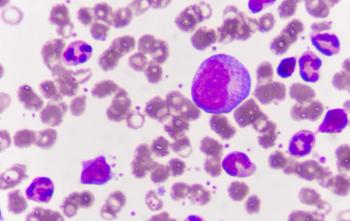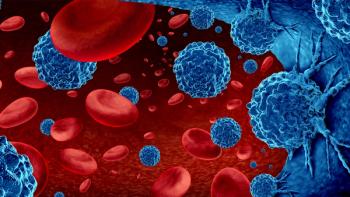
Rate of Breast Cancer-Related Lymphedema Is Higher Among Black Women Vs White Women
The 24-month lymphedema rate was 39.4% among Black women, making it the highest incidence rate in any category.
Data presented at the 2021 San Antonio Breast Cancer Symposium (SABCS) revealed that, among women breast cancer treated with axillary lymph node dissection (ALND) and radiotherapy, there is a 3.5-fold increased incidence of lymphedema among Black women, compared with non-Black individuals.
The results also indicated that Hispanic women have a 3-fold increased incidence of breast cancer–related lymphedema compared with White women. However, Andrea V. Barrio, MD, FACS, an associate attending physician in the Breast Service, Department of Surgery, at Memorial Sloan Kettering Cancer Center, noted that more data are needed to confirm this observation.
“Notably, the number of Hispanic women in our study was small,” Barrio, lead study author, explained while presenting the data during a press briefing ahead of the conference.
At the beginning of her presentation, Barrio noted that results from epidemiological studies have shown that Black women with breast cancer have an increased susceptibility to developing lymphedema. However, as she discussed, there are very little prospective clinical trial data confirming those results.
“The aim of our study was to assess the incidence of lymphedema in a prospective cohort of patients treated with axillary lymph node dissection to identify risk factors associated with lymphedema development and to evaluate the impact of race and ethnicity on lymphedema incidence and severity,” she said.
To evaluate this incidence, Barrio and her colleagues enrolled 827 women aged 18 years and older with breast cancer. Enrolled patients also had to have received a unilateral ALND either in the primary setting or after a sentinel lymph node biopsy to be eligible to be included in the analysis.
The study authors collected bilateral arm measurements using a perometer. The patients had these measurements taken at baseline, post-op and every 6 months for 2 years. A relative increase in a patient’s arm volume of 10% or greater from baseline indicated the presence of lymphedema.
After accounting for ineligible criteria, the final study enrollment comprised of 276 patients (median age, 48 years; range, 40-57 years) who had at least 1 longitudinal measurement after baseline.
More than half (60%) of the patient population was White. The remaining patient population makeup included 20% Black, 11% Asian and 6% Hispanic. Additionally, 68% of the patient population presented to the study with HR+/HER2- disease. Nineteen percent of the patients were diagnosed with HER2-positive disease and 13% of the population had hormone receptor–negative/HER2-negative disease. Seventy percent of the study population received neoadjuvant chemotherapy, while the rest underwent up-front surgery. Almost all (94%) of the patients who had up-front surgery and underwent systemic chemotherapy received a taxane-containing regimen, Barrio explained.
The treatment characteristics also indicated that 95% of patients received radiotherapy and 93% of patients received nodal RT.
When assessing clinical characteristics by race and ethnicity, White and Black women were older (median age, 49 years, respectively). Black (30.3 kg/m2) and Hispanic (28.1 kg/m2) patients had a higher baseline body mass index compared with the White (25.2 kg/m2) and Asian (22.2 kg/m2) patient populations.
At a median follow-up of 22.6 months, 56 patients developed lymphedema. The results demonstrated that the 12-month lymphedema rate was 8.8% (95% CI; 5.9-13), and that the 24-month lymphedema rate was 24.7% (95% CI; 19.2-31.5%).
Barrio noted that the highest incidence of lymphedema observed was among Black women with a 24-month lymphedema rate of 39.4%. That rate was compared with 27.7% in Hispanic women, 23.4% in Asian women, and 20.5% in White women.
The results also showed that receipt of neoadjuvant chemotherapy was associated with a higher 24-month lymphedema rate compared with up-front surgery at 30.9% vs. 11.1% (P = .0066).
The highest incidence of lymphedema observed among Black women with a 24-month lymphedema rate was 39% compared with 28% in Hispanic women, 23% in Asian women and 21% in White women.
Of note, Barrio said, among women with lymphedema, lymphedema severity did not vary across racial and ethnic groups with similar relative volume changes observed.
“We observed a higher incidence of lymphedema in black women treated with axillary lymph node dissection and radiotherapy after adjustment for other variables. Similar findings were observed in Hispanic women but confirmation in a larger data set is needed,” she said.
Barrio also highlighted how neoadjuvant chemotherapy was associated with a significant increase in lymphedema compared with adjuvant therapy in women who received ALND and RT.
As a result, Barrio concluded, “We postulate that neoadjuvant chemotherapy may cause fibrosis of tumor-filled lymphatics, as well as lymphatic endothelial damage prior to surgery, resulting in the higher lymphedema incidents observed in our study.
“In patient subsets unlikely to achieve a nodal pathologic complete response with neoadjuvant chemotherapy, alternatives to NAC to avoid ALND are needed. The etiology for the higher observed incidence of lymphedema and black women is largely unknown, but maybe due to race-based differences and inflammatory reactions, tissue fibrosis and lymphatic function. Future studies should address the biologic mechanisms behind racial disparities in lymphedema development.”
Reference
Barrio AV, et al. Impact of race and ethnicity on incidence and severity of breast cancer related lymphedema after axillary lymph node dissection: results of a prospective screening study. Presented at: 2021 San Antonia Breast Cancer Symposium; December 7-10, 2021; San Antonio, TX. Abstract GS4-01.
Newsletter
Knowledge is power. Don’t miss the most recent breakthroughs in cancer care.

















































































